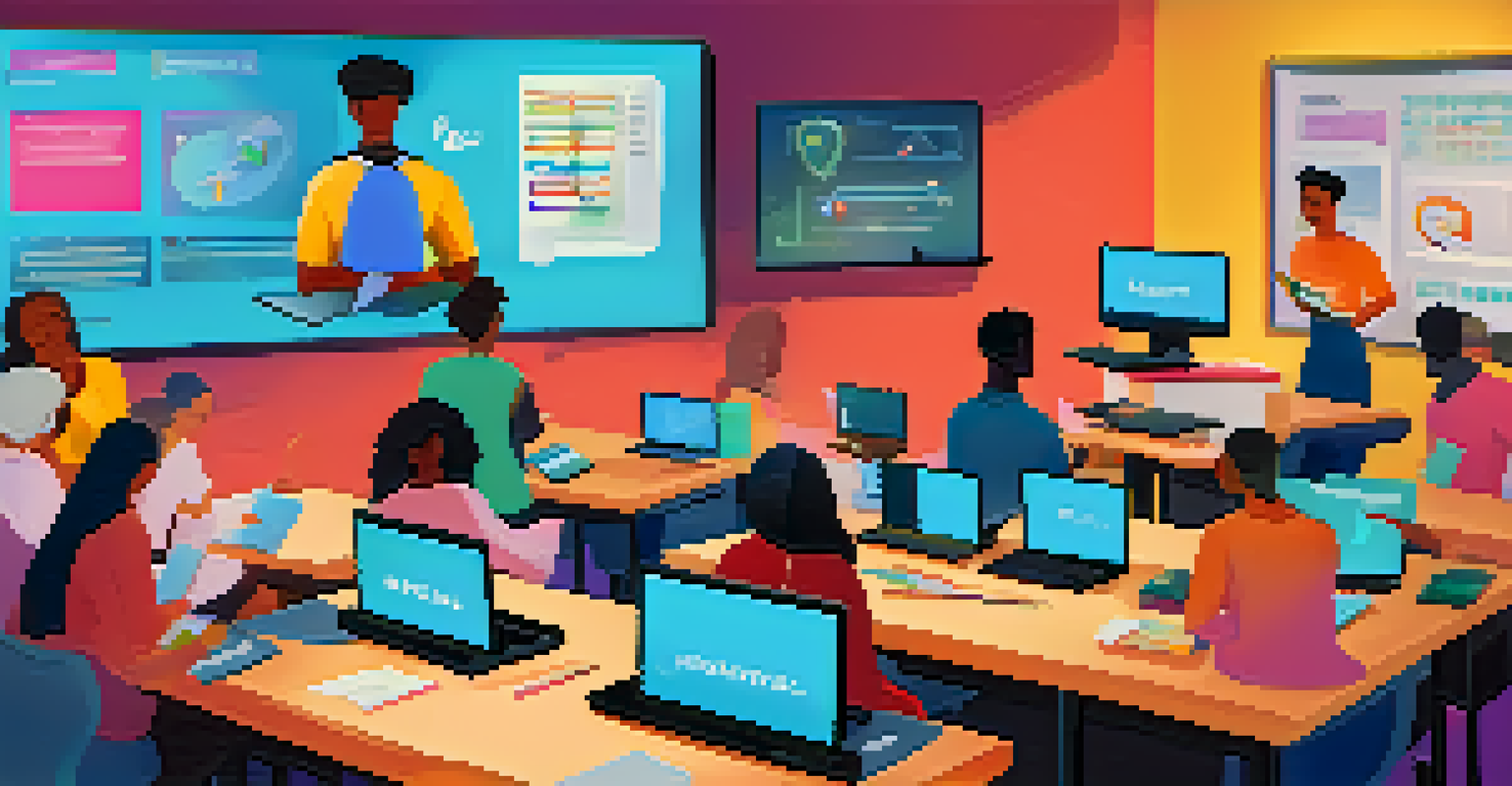The Role of Neuroplasticity in Online Learning Adaptation

What is Neuroplasticity and Why Does It Matter?
Neuroplasticity refers to the brain's remarkable ability to reorganize itself by forming new neural connections throughout life. This adaptability is crucial, especially in the context of learning. When we acquire new skills or knowledge, our brain rewires itself to accommodate this information, making it essential for effective online learning.
The brain is like a muscle. When it is in use, we feel very good. Understanding how it works will help us utilize it more effectively.
In online learning environments, where traditional classroom interactions are absent, neuroplasticity plays a vital role. Students must adapt to new methods of engagement, and understanding how their brains respond can enhance their learning experience. This adaptability means that even those who struggle with traditional learning can thrive in an online setting.
Moreover, embracing neuroplasticity encourages lifelong learning. As individuals continue to engage with new material online, they stimulate their brains to grow and adapt, reinforcing the idea that learning doesn't stop outside the classroom. This ongoing evolution can lead to a more fulfilling educational journey.
The Impact of Online Learning on Neuroplasticity
Online learning environments offer unique challenges and opportunities that can significantly influence neuroplasticity. Unlike traditional classrooms, online platforms require learners to take more responsibility for their education. This autonomy can encourage deeper engagement, prompting the brain to adapt and form new connections as students explore diverse subjects at their own pace.

For instance, when a learner encounters a difficult concept in a video lecture, they might choose to pause and research further. This proactive approach activates neuroplastic processes, as the brain works to integrate new information with existing knowledge. Over time, these repeated interactions can strengthen neural pathways, leading to improved understanding and retention.
Neuroplasticity Enhances Learning
The brain's ability to rewire itself supports effective online learning and encourages lifelong education.
Additionally, the variety of online resources—like interactive quizzes, forums, and multimedia content—can cater to different learning styles. Engaging with these varied formats stimulates multiple brain areas, promoting neuroplasticity. In essence, the more diverse the learning experiences, the more robust the brain's adaptations can become.
Strategies to Enhance Neuroplasticity in Online Learning
To fully harness the power of neuroplasticity in online learning, students can adopt specific strategies designed to enhance their cognitive flexibility. One effective method is to incorporate regular breaks into study sessions. Short breaks allow the brain to process information and form new connections, making learning more effective.
Neuroplasticity is the brain's ability to reorganize itself by forming new neural connections throughout life. It is the key to learning and adapting.
Another strategy involves the use of spaced repetition. Reviewing material at spaced intervals rather than cramming helps reinforce learning and strengthens memory. This technique aligns with how the brain naturally consolidates information, optimizing neuroplastic changes that support long-term retention.
Finally, fostering a growth mindset—believing that abilities can be developed through effort—can significantly impact neuroplasticity. When learners approach challenges with resilience and curiosity, they're more likely to engage deeply with the material, allowing their brains to adapt and grow through their online learning experiences.
The Role of Emotional Engagement in Neuroplasticity
Emotions play a significant role in the learning process, particularly in how neuroplasticity operates. When learners feel emotionally connected to the material, their brains are more likely to form strong neural connections. This is especially relevant in online learning, where it can be easy to feel isolated or disengaged from the content.
For example, using storytelling or relatable examples in online courses can evoke emotional responses. These connections enhance memory retention and understanding, as emotionally charged experiences are often more memorable than dry facts. As a result, integrating emotions into online content can facilitate neuroplastic changes that promote deeper learning.
Emotional Engagement Boosts Retention
Connecting emotionally with learning materials fosters stronger neural connections, enhancing memory retention.
Additionally, fostering a positive online learning environment—where students feel supported and valued—can boost emotional engagement. When learners feel safe to express themselves and share their thoughts, they are more likely to embrace challenges, leading to greater neuroplastic adaptations and overall success in their studies.
How Technology Affects Neuroplasticity in Learning
Technology has revolutionized the way we learn, and its impact on neuroplasticity is profound. Digital tools like adaptive learning platforms adjust content to suit individual needs, promoting personalized learning experiences. This tailored approach can enhance neuroplasticity by ensuring that learners remain challenged yet capable, leading to meaningful engagement.
Moreover, gamification—incorporating game-like elements into learning—can stimulate motivation and enhance emotional engagement. When students are actively involved and rewarded for their progress, their brains are more likely to adapt positively. This interaction encourages neural connections that support long-term learning.
However, it's essential to strike a balance. Excessive screen time or distractions can hinder neuroplasticity by overwhelming the brain. Therefore, utilizing technology mindfully—by integrating purposeful breaks and varied learning methods—can help maximize its benefits while supporting the brain's adaptability.
Overcoming Challenges to Neuroplasticity in Online Learning
While online learning offers many benefits for neuroplasticity, it also presents challenges that learners must navigate. One common hurdle is the lack of direct interaction with instructors and peers, which can lead to feelings of isolation. This disconnect can limit emotional engagement and hinder the brain’s ability to adapt effectively.
To overcome this, students can actively seek out collaboration opportunities, such as study groups or discussion forums. Engaging with others not only enhances understanding but also fosters a sense of community that can stimulate emotional connections. These connections are vital for activating neuroplasticity, as they provide support and encouragement throughout the learning journey.
Technology Shapes Learning Experiences
Digital tools and gamification personalize education, promoting engagement and boosting neuroplasticity.
Additionally, self-discipline is crucial in online learning. The flexibility of online courses can lead to procrastination or distractions if not managed well. Establishing a structured routine and setting specific goals can help learners stay focused and engaged, ensuring that their brains remain primed for neuroplastic adaptations.
Future Implications of Neuroplasticity in Education
Understanding neuroplasticity's role in online learning opens up exciting possibilities for the future of education. As research continues to unveil the brain's adaptability, educators can design more effective online curricula that leverage these insights. By incorporating strategies that promote neuroplasticity, they can create more engaging and impactful learning experiences.
For instance, future online courses may integrate advanced technologies like virtual reality or AI-driven personalized learning paths. These innovations can further enhance emotional engagement and cognitive flexibility, allowing students to learn in ways that resonate with them personally. Such advancements could lead to improved retention and understanding, ultimately transforming the educational landscape.

Moreover, as we continue to explore neuroplasticity, there's potential for developing targeted interventions for students who struggle with learning. By understanding the unique ways in which different brains adapt, educators could tailor approaches that support each learner's journey, ensuring that everyone has the opportunity to succeed in an increasingly digital world.